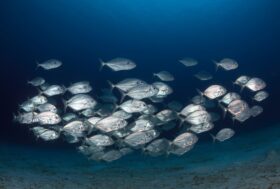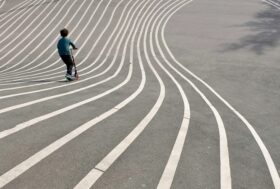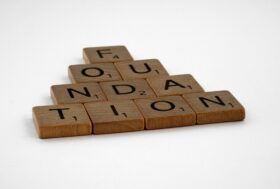Marrying ‘universal’ neurodiversity and Universal Design for Learning to enhance inclusive pedagogy: A case study from the primary school geography classroom

Irene Leach, Deputy Headteacher, Weatherfield Academy, Bedfordshire, UK
Dominic Griffiths, Visiting Research Fellow, Faculty of Health and Education, Manchester Metropolitan University, UK
Introduction
In this article, we take forward some of the ideas presented in an earlier Impact piece (Griffiths, 2020), which presented the case for using ‘neurodiversity’ as a framework for looking beyond the (SEND) labels that some learners attract, to build a more individually responsive and flexible repertoire of teaching approaches. We recap some key points about what the term ‘neurodiversity’ can mean and look at how it might be applied as a theoretical underpinning for a ‘Universal Design for Learning’ (UDL) approach to inclusive lesson planning and teaching (Meyer et al., 2014). To illustrate this, we offer the example of a UDL-based primary school geography lesson. We hope to show how the approaches used in this case study example might be more widely applied to inclusive teaching and learning.
The idea of ‘neurodiversity’
The term ‘neurodiversity’ is used in a number of different ways in current literature and on social media. While the term was originally coined by Singer (1999) as an alternative way of conceptualising the autistic spectrum, it has since been used in reference to a variety of learning differences (e.g. Baker, 2011). More recently, the term has been used to underpin the view that all humans are neurodiverse and therefore critiques the traditionally constructed ‘categories’ of SENDs used in education (e.g. Masataka, 2017). This view is finding support in the latest research in neural networks (Siugzdaite et al., 2020). We feel that this ‘universal’ model of neurodiversity offers a useful basis for developing a more personalised approach to lesson planning, and much of the recent work on developing teachers’ inclusive pedagogy seems to support an approach that moves beyond mere labels (for a summary, see Li, 2020).
What is Universal Design for Learning (UDL)?
In the USA in the 1980s, the Centre for Applied Special Technology (CAST) was founded to develop technical solutions for students with disabilities. By the 1990s, however, CAST’s research had questioned the need for a separate pedagogy for certain identified groups of learners. This was because, firstly, students did not seem to fit neatly into diagnostic categories in terms of their learning needs and, secondly, what seemed to work for certain groups of learners also worked for a much wider range of students. For example, using visuals to support text for students on the autistic spectrum is also useful for a much wider range of learners, including those with dyslexic-type and language-based challenges, those with English as an additional language and also those without given labels who find visuals engaging and memorable. Here lie the origins of the UDL philosophy.
Moving away from SEND-category-based approaches to inclusive pedagogy towards another set of organising principles, UDL draws upon a wealth of neuroscientific research to organise inclusive learning according to three core principles, based upon utilising three brain networks (these cognitive science dimensions are unpacked further in Rose and Meyer, 2002).
- Provide multiple means of engagement: This taps the brain’s affective networks – students ‘buying in’ to learning through the relevance of learning goals and provision of means to achieve them, through mastery techniques and collaborative learning
- Provide multiple means of representation: This taps the brain’s recognition systems – teaching should utilise various media flexibly (talk, pictures, film, music and multimedia technology such as text–speech software) to anchor new learning and to develop conceptual understanding from different starting points
- Provide multiple means of action and expression: This taps the brain’s strategic networks and supports the planning of ways for students to demonstrate new knowledge skills and understanding and their execution, again through a variety of media (perhaps including drama-based methods, story boards, posters, mind-maps or PowerPoints), which can be an end product themselves or a means to help plan for the challenges of extended writing.
These 3 UDL principles are each divided up into three sets of guidelines, together covering 31 numbered ‘checkpoints’ for action planning (CAST, 2022).
In keeping with this flexible and inclusive approach to pedagogy, UDL holds that inclusive whole-class lesson planning should therefore consider the diversity of student needs at the initial lesson-planning stage and not just retrofitted differentiation. This move, from more traditional ‘differentiation’, chimes well with the Teachers’ Standards espousal of a more comprehensive, integrated ‘adaptive teaching’ approach (DfE, 2011).

Rao and Meo (2016) suggest that the UDL lesson-planning cycle might be conceived as shown in Figure 1. In the key planning steps 2, 3 and 4, the emphasis is on offering a variety of media and formats for assessments, methods and materials, in accordance with the three core UDL guidelines. Examples of this are outlined in the following case study.
Case study: Applying UDL to a geography lesson for the (neuro)diversity of learners
A Year 3 primary geography lesson applied a number of UDL approaches. The intention was to provide an inclusive learning experience, regardless of learner ability. The learners carried a range of labels, including dyslexia, autism spectrum condition, speech, language and communication need, and EAL. The lesson supported the aims of the Key Stage 2 English programme of study for Year 3 (DfE, 2014), in addition to the learning goals for Milepost 2 of the International Primary Curriculum.
A 45-minute lesson introduced the topic ‘Our active planet’. To stimulate engagement, an impactful entry point, simulating a post-earthquake ‘disaster zone’, was staged in an empty classroom. A pile of cardboard boxes, upturned chairs and tables arranged in the centre of the room was cordoned off. The room was dark. A flashing orange light and smoke machine were hidden within the ‘rubble’; siren and burning fire sound effects added to the drama of the scene. A range of choices were offered as to how learners wanted to experience the entry point; this encouraged some to take on specific roles to support the learning of the whole group (described below).
The lesson promoted participation and interaction, the development of communication and language skills, and the development of contextual and conceptual understanding relating to the theme, as well as collaboration. Reflecting on the UDL principles already outlined above, their relationship to this particular lesson is illustrated below, demonstrating how the approaches applied in the lesson map onto the core principles.
Provide multiple means of engagement and action
In the previous lesson, learners had voted for this topic. Teacher questioning gauged levels of understanding. A pre-teach vocabulary session focused on enabling access to the specific topic language. This approach was found to be beneficial to all learners, preparing them for the ensuing lesson, in which they would purposefully apply this prior learning. The immersive and multisensory ‘disaster zone’ entry point succeeded as a ‘hook’, and choices for engagement were made enthusiastically: some learners walked around the zone acting as observers; some observed from afar, recording the ‘event’ by taking video footage and photographs using tablets; others made voice recordings of peers’ comments and their responses when asked questions about their experience; and they also recorded their own thoughts on what they could see, hear, smell and feel. Masks and ear defenders were offered to learners before they entered the disaster zone, enabling self-management of sensory sensitivities. Learner feedback and a group discussion followed, before reporting on their experience in various ways.
Provide multiple means of representation
Topic-related keywords were provided, with supporting photographs, illustrations and symbols prominently displayed on a ‘learning wall’, providing a permanent reference point throughout the topic that supported writing tasks – learners independently visited the wall to seek specific information to support their learning. A range of colours, fonts and sizes was used in all text presented, accommodating learners’ preferences; this gave access to those learners experiencing visual differences. Information was presented sequentially, serving as a learning ladder to support scaffolded knowledge building, according to the stages of learning as exemplified in the revised version of Bloom’s taxonomy (Anderson and Krathwohl, 2001). Video clips of earthquake disaster zones were shown as a means to extend discussion and to draw comparisons between the real and the staged ‘disaster zone’. The learners’ photographs, film and voice recordings anchored learning to reinforce the concepts discussed. Expanding the availability and range of visuals throughout the lesson appeared to support learner recall of the lesson content and topic keywords for weeks afterwards. The teacher’s use of Makaton and British Sign Language enabled access for hearing-impaired learners and those for whom receptive language skills required additional visual support.
Provide multiple means of expression
In preparation to record their experiences, choice was again given to work alone, in pairs or in a small group. Access was provided to a range of means of expression: the use of video/voice recordings, drawing, mind-maps, news reports, comic strips/storyboards, PowerPoint presentations, handwriting or typing, use of speech-to-text facilities, and use of words and pictures – writing was supported by frames created according to learner needs, while spellcheck facilities were provided for editing purposes. Offering choices for expression that engage learner preferences is key to maintaining interest. All learners were very well engaged throughout the lesson and were keen to communicate their experience in a meaningful and personal way. The key vocabulary relating to this episode of learning was found to have been utilised effectively both verbally and in writing, demonstrating and securing a level of contextual understanding that would be further developed in later lessons. The teaching assistant worked as a scribe, also supporting expressive language development via scaffolded questioning. All work was presented on the learning wall, with access to voice and video recordings using QR codes, celebrating the achievements of the whole class in one display.
Conclusions
We hope to have shown that inclusive teaching, based upon a UDL framework, can provide learners with multiple means to receive, express and demonstrate their understanding without having to negotiate barriers, rather than adopting an attitude of ‘one size fits all’ and bolting on differentiated tasks for ‘the SEND kids’. Inclusive pedagogy aims to carefully select and prepare materials and resources, creatively staging learning environments and experiences that motivate, engage and engender collaborative working. Of course, a level of caution should be exercised when planning lessons to avoid inadvertently creating barriers. How teachers might challenge their own biases by thinking ‘neurodiversity’ rather than ‘divergence/ deficit’ should be considered. Responding sensitively and with awareness to the diversity of learning needs and preferences in their classrooms is a positive move towards building inclusive pedagogies. This will not be achieved overnight. We suggest that teachers gradually adopt the UDL principles into their practice, perhaps as incrementally as one or two new UDL checkpoints at a time. They may well find that they are already using many of these in their current teaching repertoire. We believe that the principles of UDL provide teachers with opportunities to take steps towards creating inclusive and rich learning environments that bring learners together in the true spirit of inclusion.
- Anderson L and Krathwohl D (2001) A Taxonomy for Learning, Teaching and Assessing: A Revision of Bloom’s Taxonomy of Educational Objective. New York: Longman Publishing.
- Baker D (2011) The Politics of Neurodiversity: Why Public Policy Matters. Boulder CO: Lynne Rainer.
- Department for Education (DfE) (2011) Teachers’ standards. Available at: www.gov.uk/government/publications/teachers-standards (Accessed 24 March 2022).
- Department for Education (DfE) (2014) National Curriculum in England: English programmes of study. Available at: www.gov.uk/government/publications/national-curriculum-in-england-english-programmes-of-study (accessed 22 March 2022).
- CAST (2022) About Universal Design for Learning. Available at: www.cast.org/impact/universal-design-for-learning-udl (accessed 29 March 2022).
- Griffiths D (2020) Teaching for neurodiversity: Training teachers to see beyond labels. Impact 8: 56–59.
- Li E (2020) Developing inclusive pedagogy: Some theoretical insights from research evidence. Impact 9: 42–43.
- Masataka N (2017) Implications of the idea of neurodiversity for understanding the origins of developmental disorders. Physics of Life Review 20: 85–86.
- Meyer A, Rose D and Gordon D (2014) Universal Design for Learning: Theory and Practice. Wakefield, Massachusetts: CAST Professional Publishing.
- Rao K and Meo G (2016) Using Universal Design for Learning to design standards-based lessons. SAGE Open 6(4): 1–12.
- Rose DH and Meyer A (2002) Teaching Every Student in the Digital Age: Universal Design for Learning. Alexandria, Virginia: ASCD.
- Singer J (1999) ‘Why can’t you be normal for once in your life?’ From a ‘problem with no name’ to the emergence of a new category of difference. In: Corker M and French S (eds) Disability Discourse. Buckingham/Philadelphia: Open University Press, pp. 59–67.
- Siugzdaite R, Bathelt J, Holmes J et al. (2020) Transdiagnostic brain mapping in developmental disorders. Current Biology 30(7): 1245–1257.










